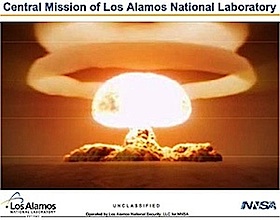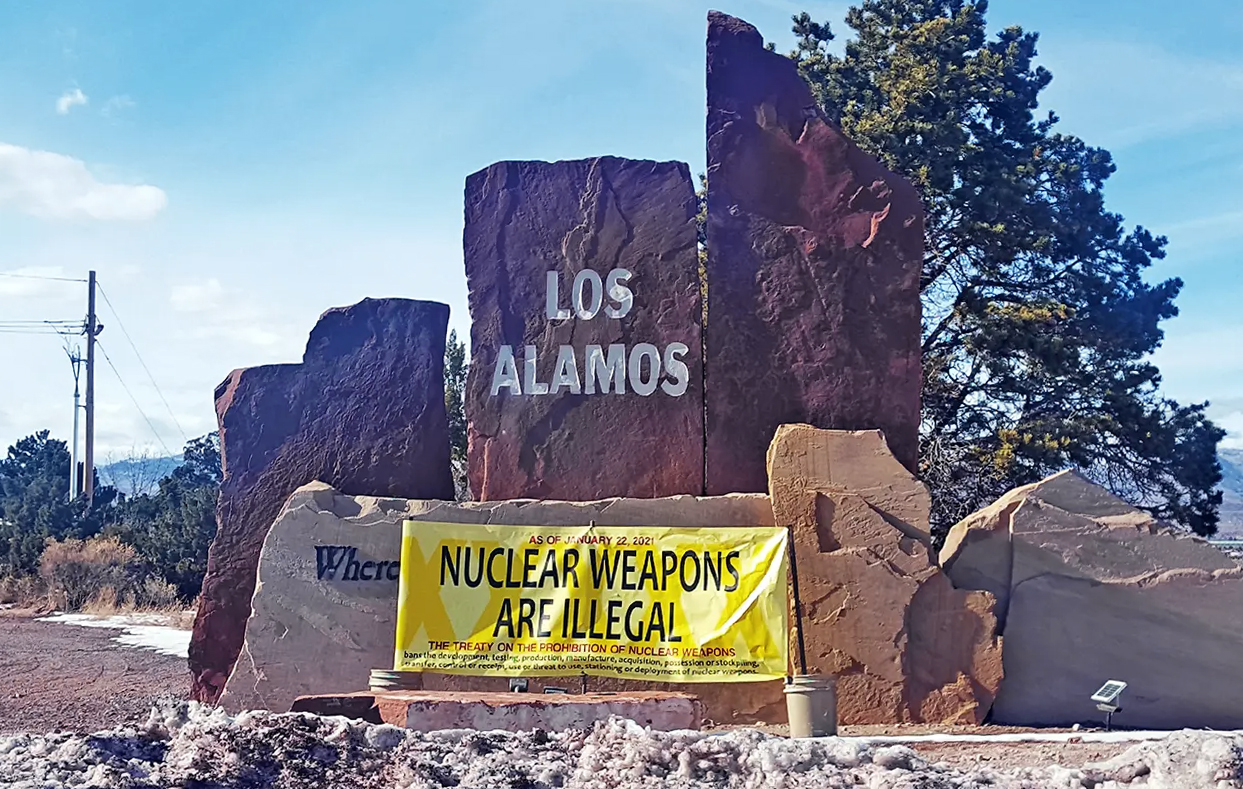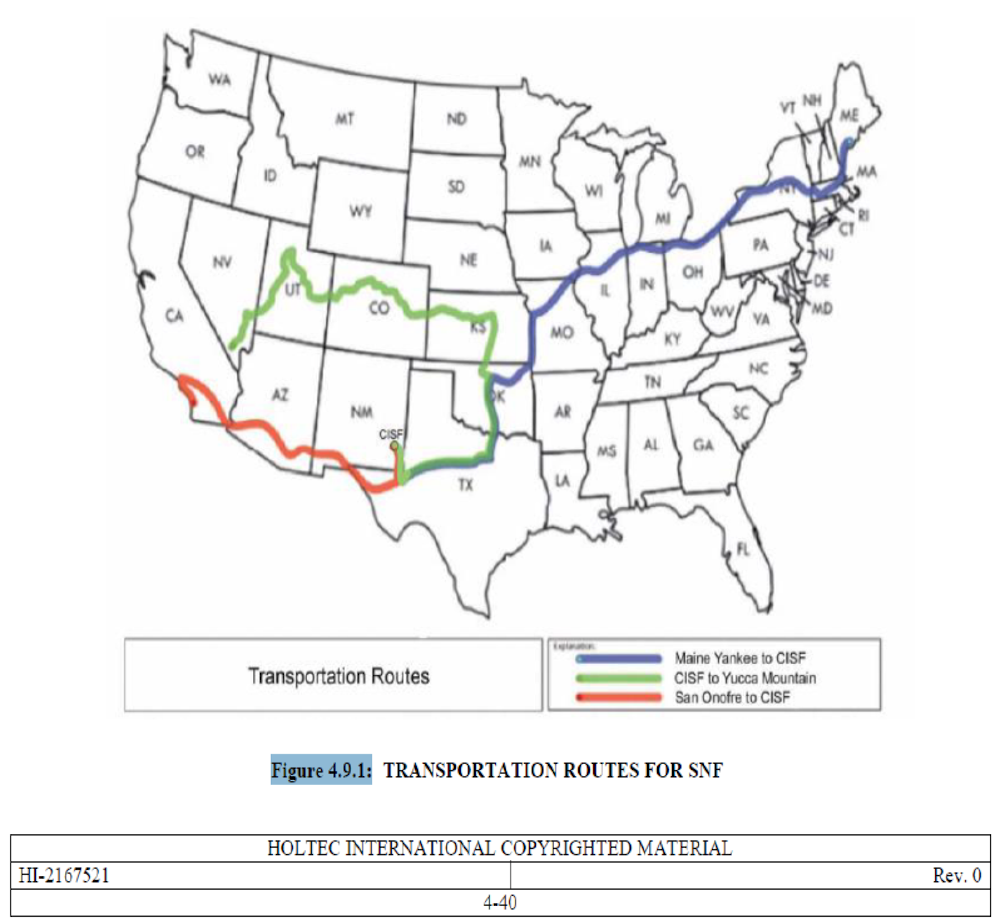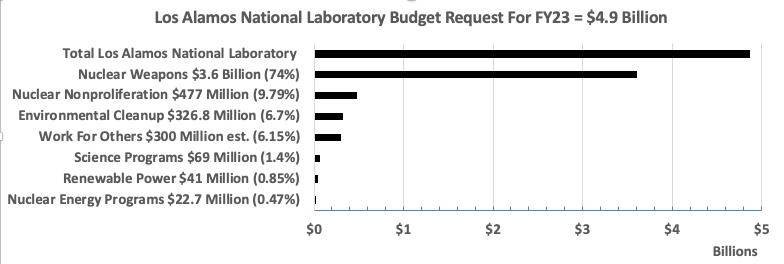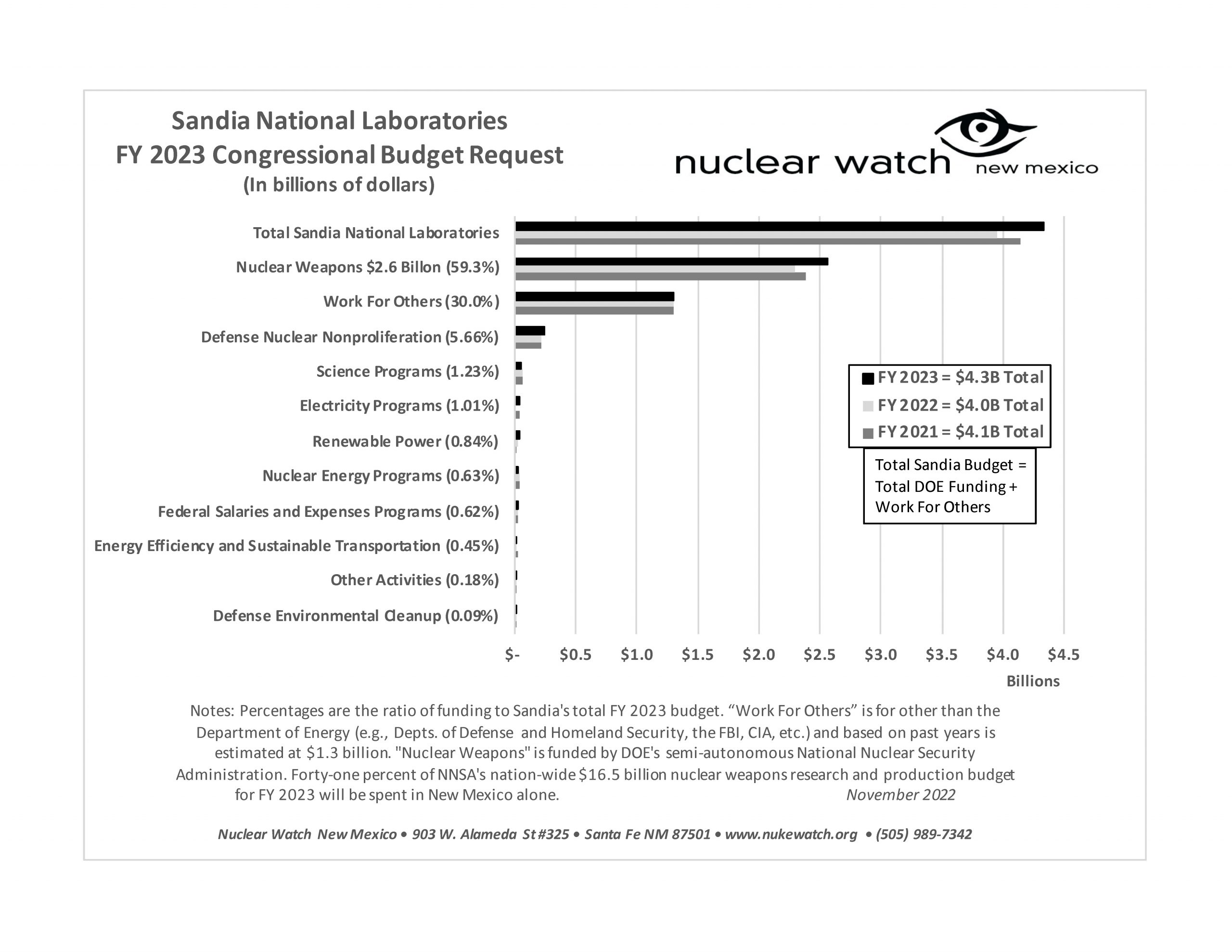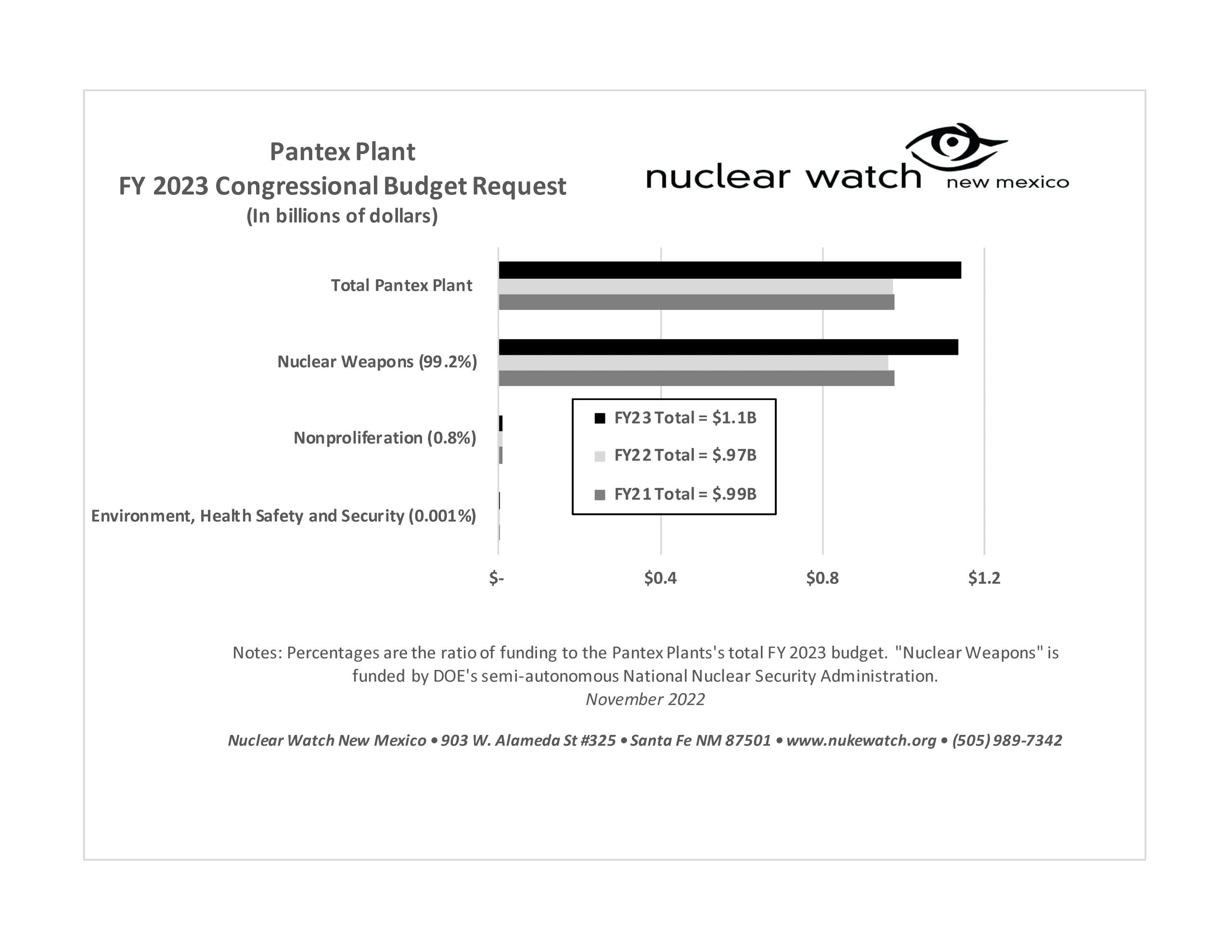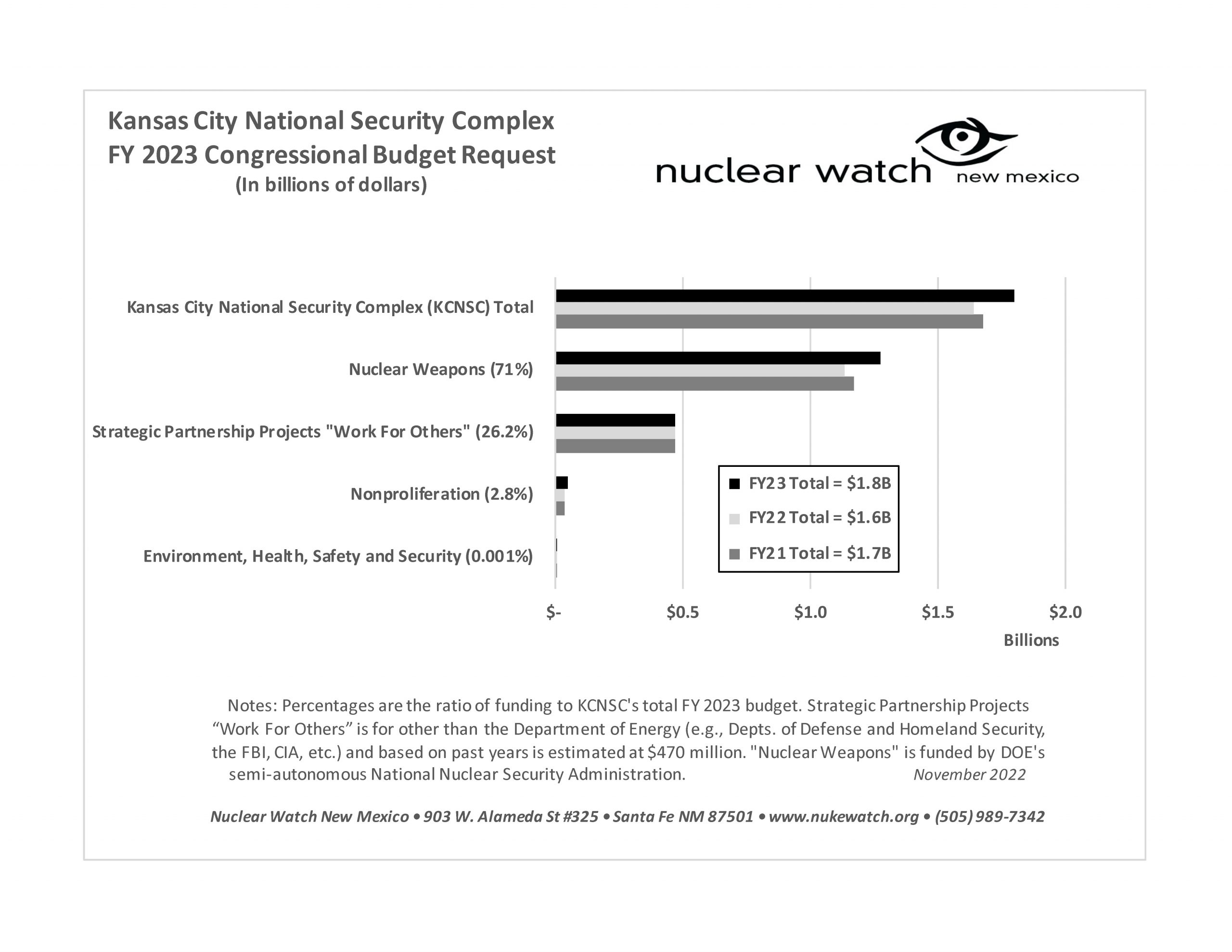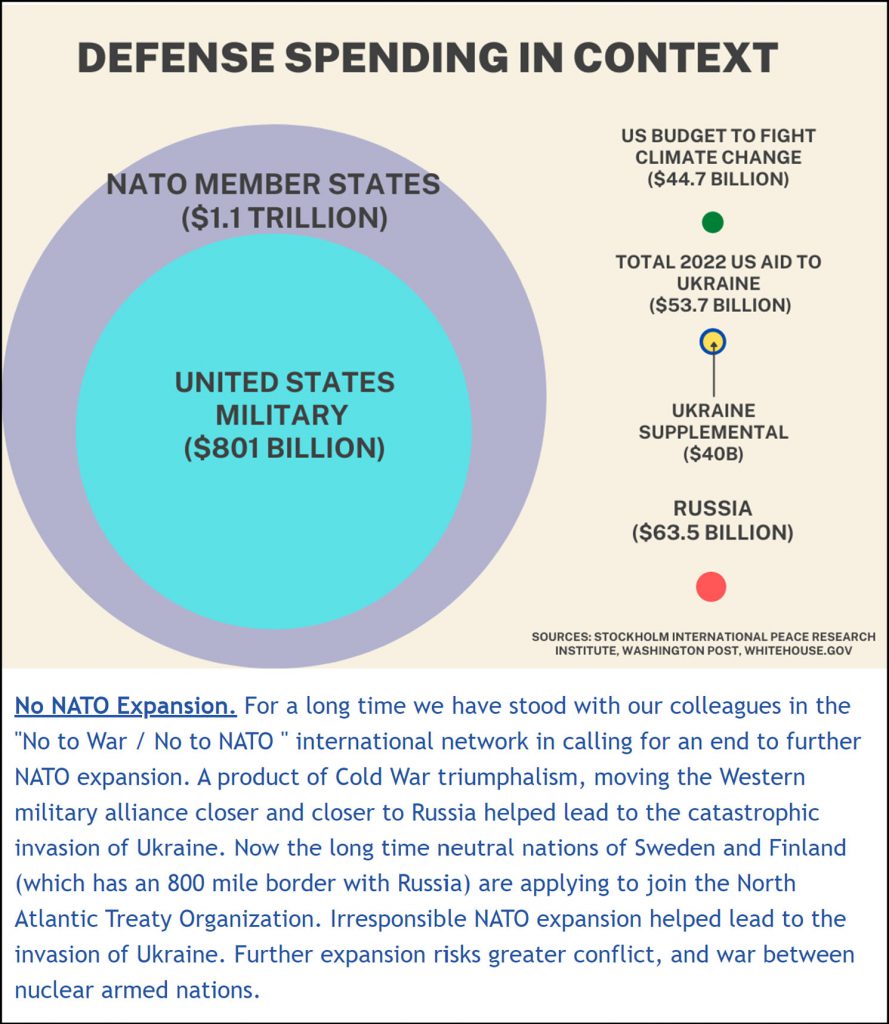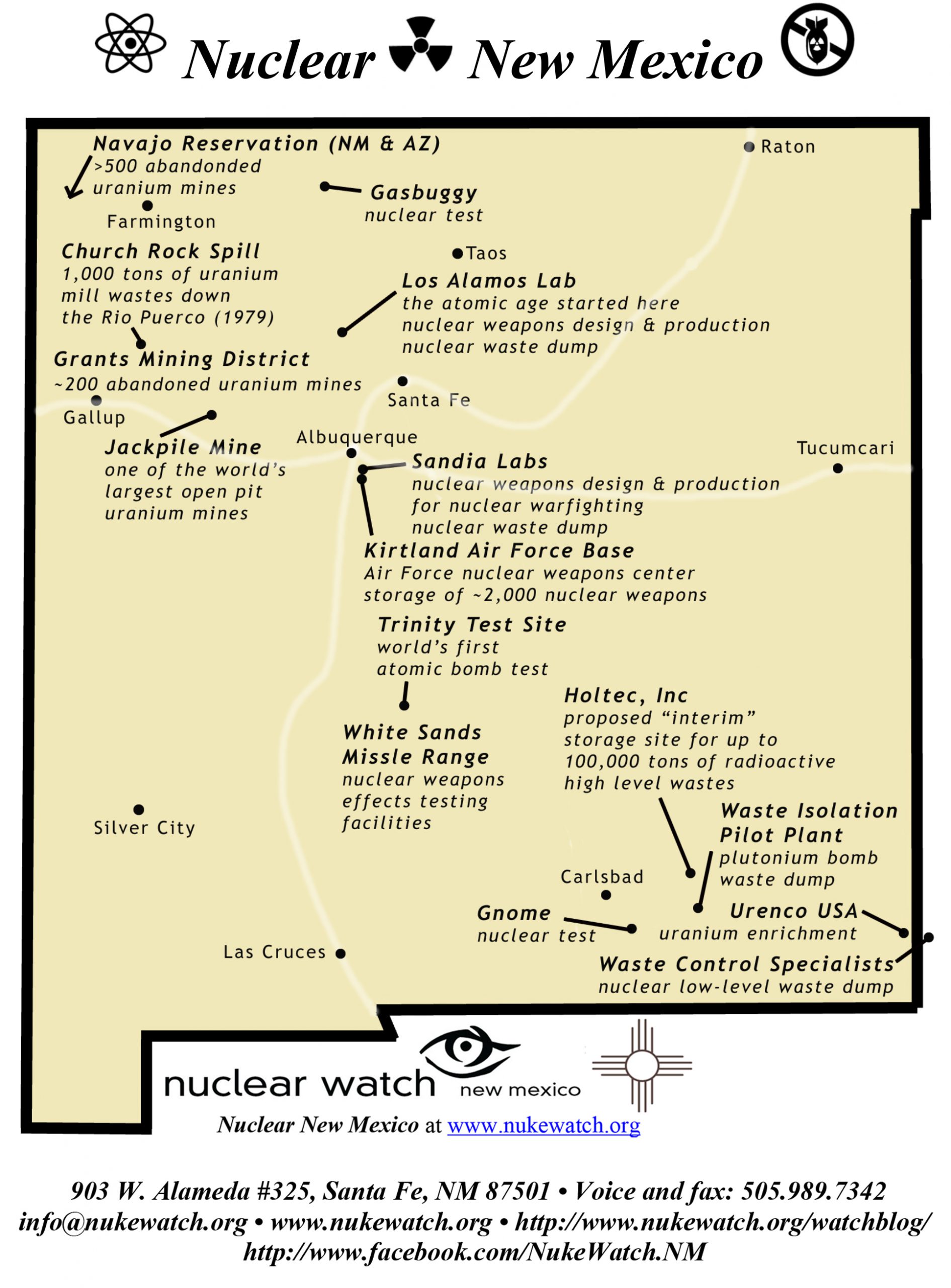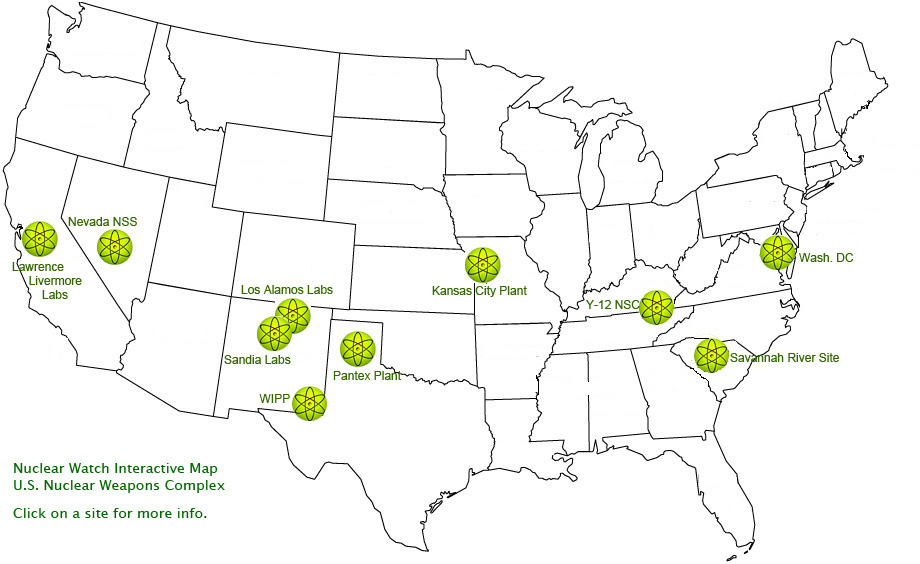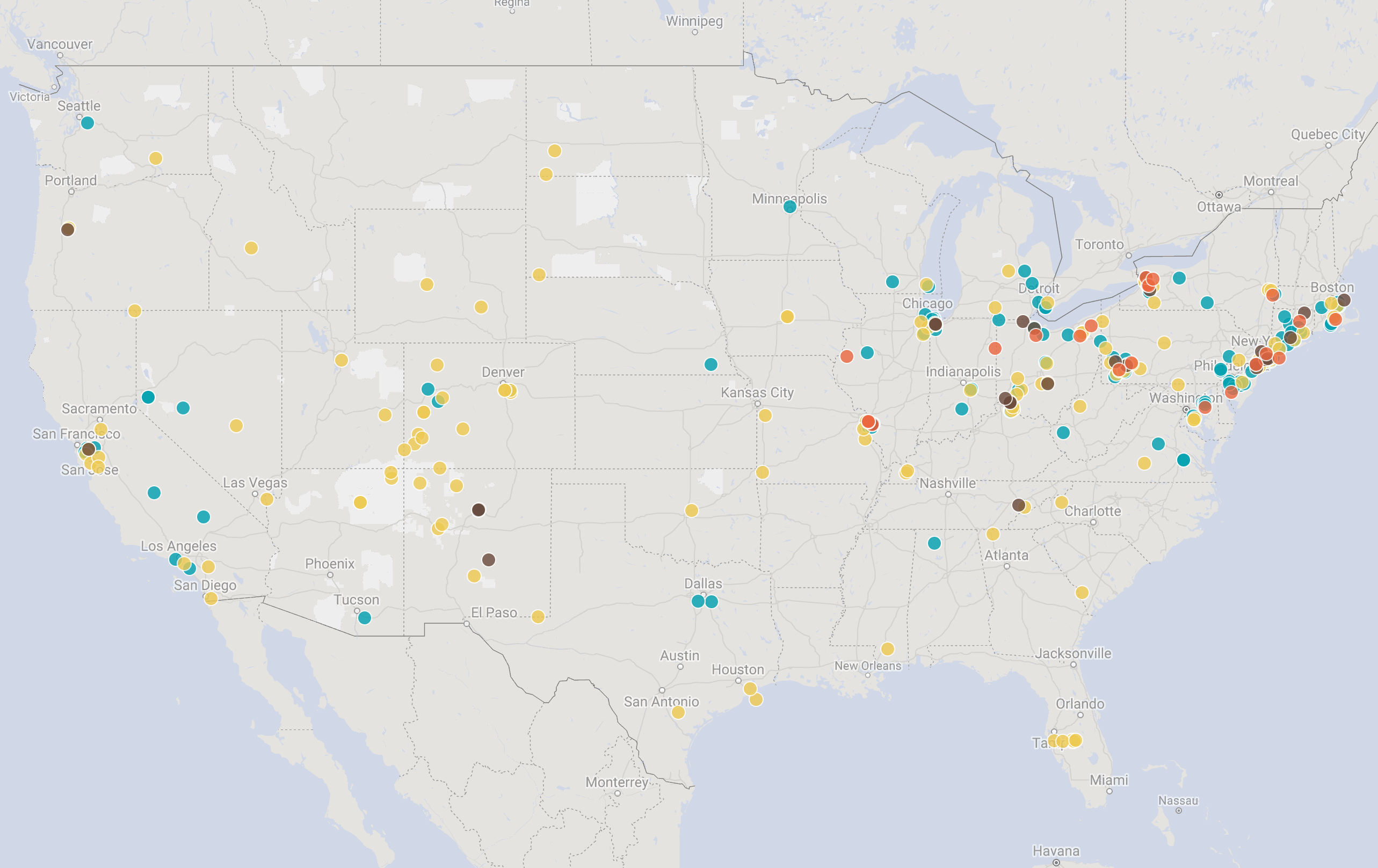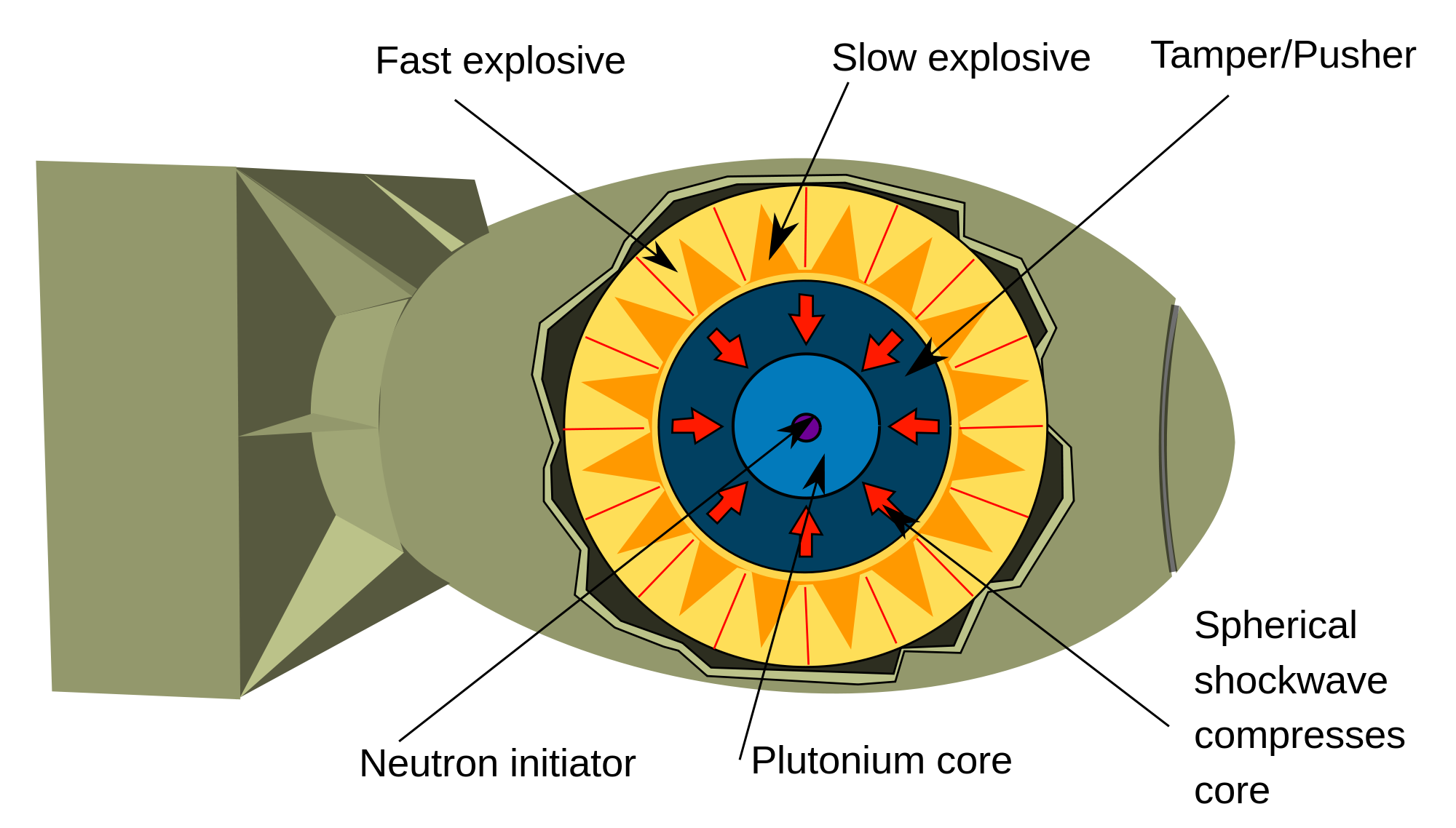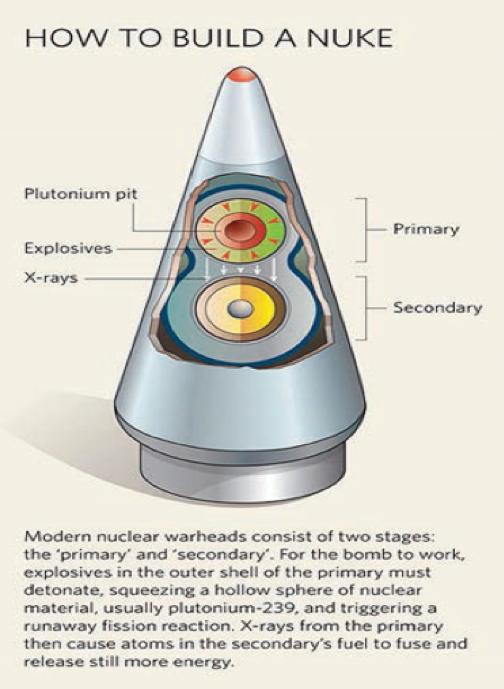QUOTE OF THE WEEK
Nothing Found
It seems we can’t find what you’re looking for. Perhaps searching can help.
LANL’s Central Mission: Los Alamos Lab officials have recently claimed that LANL has moved away from primarily nuclear weapons to “national security”, but what truly remains as the Labs central mission? Here’s the answer from one of its own documents:
LANL’s “Central Mission”- Presented at: RPI Nuclear Data 2011 Symposium for Criticality Safety and Reactor Applications (PDF) 4/27/11
Banner displaying “Nuclear Weapons Are Now Illegal” at the entrance in front of the Los Alamos National Lab to celebrate the Entry Into Force of the Nuclear Weapon Ban Treaty on January 22, 2021
Nothing Found
It seems we can’t find what you’re looking for. Perhaps searching can help.
Follow the Money!
Map of “Nuclear New Mexico”
Nuclear Watch Interactive Map – U.S. Nuclear Weapons Complex
In 1985, US President Ronald Reagan and and Russian President Mikhail Gorbachev declared that “a nuclear war cannot be won and must never be fought.”
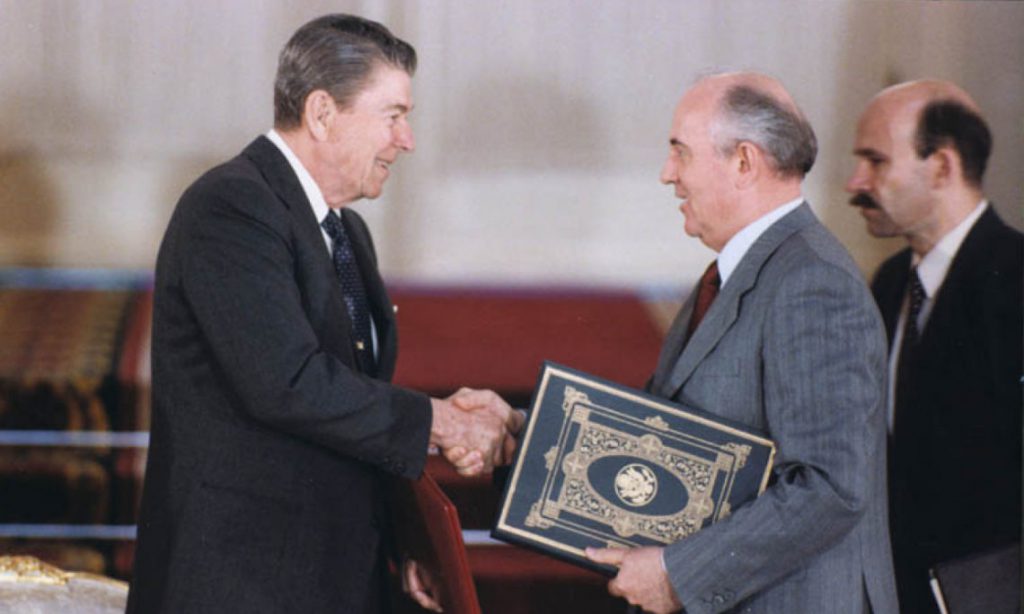
Waste Lands: America’s Forgotten Nuclear Legacy
The Wall St. Journal has compiled a searchable database of contaminated sites across the US. (view)
Related WSJ report: https://www.wsj.com
2022 BLOG POSTS
Nothing Found
It seems we can’t find what you’re looking for. Perhaps searching can help.
New & Updated
A Preview of Trump’s Budget: More Nuclear Bombs and Plutonium Pit Production
Santa Fe, NM.
The proposed level of funding for the National Nuclear Security Administration’s (NNSA)’s Total Weapons Activities is $10.2 billion, a full billion above what was requested for FY 2017. In March, Trump’s “skinny budget” stated NNSA’s funding priorities as ‘moving toward a responsive nuclear infrastructure’, and ‘advancing the existing warhead life extension programs’.
Concerning Life Extension Programs, rather than merely maintaining and extending the lives of existing nuclear weapons as advertised, they are being given new military capabilities, despite denials at the highest levels of government. A current example is the B61-12 Life Extension Program, which is transforming a “dumb” nuclear bomb into the world’s first highly accurate “smart” nuclear bomb.
With respect to the Los Alamos National Laboratory (LANL), “responsive infrastructure” no doubt means accelerating upgrades to existing plutonium facilities and likely building two or three new underground “modules”, all for the purpose of quadrupling plutonium pit production from 20 to 80 pits per year. (Plutonium pits are the fissile cores of nuclear weapons.)
How could New Mexico’s senators support Heather Wilson for Air Force Secretary?
Commentary by NukeWatch Steering Committee member Chuck Montaño. Chuck is a federally protected LANLK whistleblower, and we’re proud to have him!
*******
It’s disturbing, but not surprising that both New Mexico U.S. Senators, and so many of their Senate colleagues, supported Donald Trump’s nomination of former New Mexico Congresswomen, Heather Wilson, to the position of Air Force Secretary. My award-winning book about the corrupting influence of money and politics, titled Los Alamos: Secret Colony, Hidden Truths, provides in depth perspective on how this occurs and why, regardless of political party affiliation.
According to the Association of Certified Fraud Examiners, most fraud, waste and abuse can be attributed to managerial malfeasance occurring at the highest levels of leadership, and a reluctance(if not outright refusal) by those with oversight authority to hold those responsible accountable. A couple of years back, Ms Wilson was caught lobbying for the Los Alamos National Laboratory, Sandia, and other federal facilities, she receiving tens of thousands of dollars a month in the process. These federal installations were later forced to reimburse the taxpayer for those monies, this being akin to the proverbial slap on the wrist with a wet noodle.
As a former auditor and fraud investigator in Los Alamos, and the once director of fraud and special investigations for the office of the New Mexico state auditor, I know for a fact that using taxpayer dollars to lobby is a blatant violation of federal and state law. I also know that employees are legally required to report fraud, waste and abuse occurring at taxpayer-funded institutions. Indeed, it is a condition of employment at federally-funded facilities. So why did New Mexico U.S. Senator’s Tom Udall and Martin Heinrich, and so many of their Senate colleagues, choose to ignore the evidence about Wilson’s lobbying activity, introduced into the record at her recent confirmation hearing? Indeed, why do our elected representatives prefer to look the other way as government whistleblower’s (AKA employees) careers get destroyed, by these employers, for reporting such malfeasance? Perhaps we are a nation of laws, but the institutions and individuals charged to enforce them are clearly selective as to how and when they choose to do so, thus ensuring the powerful get their way and, perhaps most importantly, that the status quo always always remains intact.
Charles ‘Chuck’ Montano, author Los Alamos: Secret Colony, Hidden Truths www.losalamosdiary.com
Trump adds to DC muck with Heather Wilson as Air Force Secretary
So much for draining the swamp. Trump and the Senate just added to the muck in Washington, DC by confirming ex-Congresswoman Heather Wilson as Secretary of the Air Force. Lockheed Martin, the world’s biggest weapons contractor, started paying her $10,000 a month the day after she stepped down from office to help devise a strategy to extend its $2.6 bilion/year management contract of the Sandia Labs without competitive bid (the Labs are in her district). She went on to get a similar contract with the Los Alamos Lab, also for $10,000 a month. Good work, if you can get it!
Now as Air Force Secretary she will oversee the world’s most expensive weapons systems made by guess who? Lockheed Martin. All this for a Defense Department that has never been able to pass a financial audit for how it spends taxpayers’ money. Sadly, it’s business it as usual for the weapons megabusiness.
In particular, it’s especially hypocritical for New Mexico’s senior senator Tom Udall to have voted for her, given that he sent out an email fundraiser immediately after Trump’s speech to Congress denouncing his cabinet nominee’s conflicts-of-interest. I think it shows that the New Mexican congressional delegation’s primary loyalty is to the nuclear weapons industry in our state, instead of to political party or even good governance.
In contrast, praise and glory to California’s senior senator Dianne Feinstein who issued a strong statement against Heather Wilson because of her possibly illegal lobbying activities. Both the Sandia and Los Alamos Labs had to pay back the US government the ~$430,000 they had been reimbursed for paying her, but there is no public record of Wilson ever paying back one red cent.
How US Nuclear Force Modernization is Undermining Strategic Stability

A must read:
How US Nuclear Force Modernization is Undermining Strategic Stability:
The Burst-Height Compensating Super-Fuze
By Hans M. Kristensen, Matthew McKinzie, Theodore A. Postol
https://web.archive.org/web/20180623204508/https://thebulletin.org/how-us-nuclear-force-modernization-undermining-strategic-stability-burst-height-compensating-super10578
Excerpt:
The US nuclear forces modernization program has been portrayed to the public as an effort to ensure the reliability and safety of warheads in the US nuclear arsenal, rather than to enhance their military capabilities. In reality, however, that program has implemented revolutionary new technologies that will vastly increase the targeting capability of the US ballistic missile arsenal. This increase in capability is astonishing- boosting the overall killing power of existing US ballistic missile forces by a factor of roughly three- and it creates exactly what one would expect to see, if a nuclear-armed state were planning to have the capacity to fight and win a nuclear war by disarming enemies with a surprise first strike.
This is a super outstanding analysis by Mssrs. Kristensen, McKinzie and Postol. I’m no doubt naïve, but I’m hoping it will have some real political and geopolitical impact.
And how in keeping with the 2013 Defense Dept. guidance, which Kristensen was the first to point out to me. It helps to demonstrate that the American public doesn’t really have nuclear “deterrence” as claimed for a half-century. Instead, the U.S. has always had a nuclear war-fighting strategy, as first demonstrated in Hiroshima and Nagasaki.
To quote:
The new guidance requires the United States to maintain significant counterforce capabilities against potential adversaries. The new guidance does not rely on a “counter-value’ or “minimum deterrence” strategy.
Report on Nuclear Implementation Strategy of the United States Specified in Section 491 of 10. U.S.C., Department of Defense, June 2013, page 4 (quotation marks in the original) http://www.globalsecurity.org/wmd/library/policy/dod/us-nuclear-employment-strategy.pdf
As Kristensen, McKinzie and Postol point out, the geopolitical risks in radical improvements to U.S. nuclear warfighting capabilities are enormous. A secondary concern I’d like to point out is the risk to nuclear weapons reliability posed by intentionally introducing major changes to an extensively tested stockpile.
The Pantex Plant (final assembly site for US nuclear weapons) has a newsletter called The Pantexan (duh!). I recall circa 2009 that it had an article concerning the fact that the MC 4700 “super fuze” that was being installed in the then-ramping up W76 Life Extension Program had initial design and production problems. As the article boasted, those defects were detected and swiftly corrected.
However, the principle remains that introducing intentional changes can undermine confidence in stockpile reliability. The grand irony is that the Stockpile Stewardship Program has been lavishly funded because of the official rationale of preserving stockpile reliability, but I believe it has been a Trojan horse all along for using Life Extension Programs to create new military capabilities (and which the excellent analysis above reinforces).
[I have tried a few times to again find that Pantexan article, unfortunately without success.]
The above graph from the 1993 Sandia Stockpile Life Study shows that the supermajority of nuclear weapons defects occur within the first 5 years from the First Production Unit. Marylia Kelley (Executive Director of TriValley CAREs that watchdogs Livermore Lab ) and I met with Vic Reis, commonly regarded as the “father” of the Stockpile Stewardship Program, in 2004 or 2005. He explicitly said to us that the whole purpose of the Stockpile Stewardship Program was for the “other side of the bathtub curve”, i.e. when defects were going to multiply because of aging.
Guess what? That hasn’t happened, given long-established stockpile surveillance, rigorous maintenance and well-understood replacement of “limited life components” (e.g., batteries, neutron generators, tritium).
Indeed, the 1993 Sandia Stockpile Life Study itself said
We undertook this study to understand how long nuclear weapons last. We quickly learned that this is the wrong question. It is clear that, although nuclear weapons age, they do not wear out; they last as long as the nuclear weapons community (DOE and DOD) desire. In fact, we can find no example of a nuclear weapon retirement where age was ever a major factor in the retirement decision.
The more significant question is “what does it take to sustain a weapon while it is in the stockpile?”… Failures, defects, and aging problems have been rare…
[Available at https://nukewatch.org/facts/nwd/Sandia_93_StockpileLife.pdf]
So again, I think the Stockpile Stewardship Program has been a ruse to indefinitely preserve U.S. nuclear weapons while giving them new military capabilities. And now we have the trillion dollar-plus “modernization” to vastly expand U.S. nuclear warfighting capabilities.
How US Nuclear Force Modernization is Undermining Strategic Stability
A must read:
Nuclear Weapons defects graph from 1993 Sandia Stockpile Life Study
How US Nuclear Force Modernization is Undermining Strategic Stability:
The Burst-Height Compensating Super-Fuze
By Hans M. Kristensen, Matthew McKinzie, Theodore A. Postol
https://web.archive.org/web/20180623204508/https://thebulletin.org/how-us-nuclear-force-modernization-undermining-strategic-stability-burst-height-compensating-super10578
Excerpt:
“The US nuclear forces modernization program has been portrayed to the public as an effort to ensure the reliability and safety of warheads in the US nuclear arsenal, rather than to enhance their military capabilities. In reality, however, that program has implemented revolutionary new technologies that will vastly increase the targeting capability of the US ballistic missile arsenal. This increase in capability is astonishing- boosting the overall killing power of existing US ballistic missile forces by a factor of roughly three- and it creates exactly what one would expect to see, if a nuclear-armed state were planning to have the capacity to fight and win a nuclear war by disarming enemies with a surprise first strike.”
This is a super outstanding analysis by Mssrs. Kristensen, McKinzie and Postol. I’m no doubt naïve, but I’m hoping it will have some real political and geopolitical impact.
And how in keeping with the 2013 Defense Dept. guidance, which Kristensen was the first to point out to me. It helps to demonstrate that the American public doesn’t really have nuclear “deterrence” as claimed for a half-century. Instead, the U.S. has always had a nuclear war-fighting strategy, as first demonstrated in Hiroshima and Nagasaki.
To quote:
The new guidance requires the United States to maintain significant counterforce capabilities against potential adversaries. The new guidance does not rely on a “counter-value’ or “minimum deterrence” strategy.
Report on Nuclear Implementation Strategy of the United States Specified in Section 491 of 10. U.S.C., Department of Defense, June 2013, page 4 (quotation marks in the original) http://www.globalsecurity.org/wmd/library/policy/dod/us-nuclear-employment-strategy.pdf
As Kristensen, McKinzie and Postol point out, the geopolitical risks in radical improvements to U.S. nuclear warfighting capabilities are enormous. A secondary concern I’d like to point out is the risk to nuclear weapons reliability posed by intentionally introducing major changes to an extensively tested stockpile.
The Pantex Plant (final assembly site for US nuclear weapons) has a newsletter called The Pantexan (duh!). I recall circa 2009 that it had an article concerning the fact that the MC 4700 “super fuze” that was being installed in the then-ramping up W76 Life Extension Program had initial design and production problems. As the article boasted, those defects were detected and swiftly corrected.
However, the principle remains that introducing intentional changes can undermine confidence in stockpile reliability. The grand irony is that the Stockpile Stewardship Program has been lavishly funded because of the official rationale of preserving stockpile reliability, but I believe it has been a Trojan horse all along for using Life Extension Programs to create new military capabilities (and which the excellent analysis above reinforces).
[I have tried a few times to again find that Pantexan article, unfortunately without success.]
Below is a graph (pending) from the 1993 Sandia Stockpile Life Study which shows that the supermajority of nuclear weapons defects occur within the first 5 years from the First Production Unit. Marylia Kelley (Executive Director of TriValley CAREs that watchdogs Livermore Lab ) and I met with Vic Reis, commonly regarded as the “father” of the Stockpile Stewardship Program, in 2004 or 2005. He explicitly said to us that the whole purpose of the Stockpile Stewardship Program was for the “other side of the bathtub curve”, i.e. when defects were going to multiply because of aging.
Guess what? That hasn’t happened, given long-established stockpile surveillance, rigorous maintenance and well-understood replacement of “limited life components” (e.g., batteries, neutron generators, tritium).
Indeed, the 1993 Sandia Stockpile Life Study itself said
We undertook this study to understand how long nuclear weapons last. We quickly learned that this is the wrong question. It is clear that, although nuclear weapons age, they do not wear out; they last as long as the nuclear weapons community (DOE and DOD) desire. In fact, we can find no example of a nuclear weapon retirement where age was ever a major factor in the retirement decision.
The more significant question is “what does it take to sustain a weapon while it is in the stockpile?”… Failures, defects, and aging problems have been rare…
[Available at https://nukewatch.org/facts/nwd/Sandia_93_StockpileLife.pdf]
So again, I think the Stockpile Stewardship Program has been a ruse to indefinitely preserve U.S. nuclear weapons while giving them new military capabilities. And now we have the trillion dollar-plus “modernization” to vastly expand U.S. nuclear warfighting capabilities.

Russia Violates Important Arms Control Treaty, While US Presses Ahead With Destabilizing Strategic Advantages
There is this important article today:
US General Says Russia Has Deployed Banned Missile
WASHINGTON — A senior U.S. general on Wednesday accused Russia of deploying a land-based cruise missile in violation of “the spirit and intent” of a nuclear arms treaty and charged that Moscow’s intention is to threaten U.S. facilities in Europe and the NATO alliance.
“We believe that the Russians have deliberately deployed it in order to pose a threat to NATO and to facilities within the NATO area of responsibility,” Gen. Paul Selva, vice chairman of the Joint Chiefs of Staff, told a House Armed Services Committee hearing….
Nuclear Watch New Mexico definitely takes treaty violations seriously. But left unsaid is the fact that the US is acquiring 1,000 new nuclear-armed cruise missiles permitted under New START, which because of that, despite what Trump says, is a better deal for the US than Russia.
Then there is the pending forward deployment in Europe of new B61-12s with new military capabilities (the world’s first “smart” nuclear bomb), plus the ongoing increase in hard target kill capability “boosting the overall killing power of existing US ballistic missile forces by a factor of roughly three…”, as so well recently explained by Kristensen, McKinzie and Postal. See https://web.archive.org/web/20180623204508/https://thebulletin.org/how-us-nuclear-force-modernization-undermining-strategic-stability-burst-height-compensating-super10578
Then there is American chest thumping about new threats to NATO, but left unsaid is NATO expansionism to the borders of Russia; and American abrogation of the ABM Treaty, leading to ballistic missile defenses in Europe that could destabilize “deterrence.”
Yes, treaties are essential, but as usual hard nosed military capabilities unfortunately rule the day. It’s a wonder that Russia’s nuclear posture isn’t actually more aggressive than it is in the face of new American threats.
Of course the nuclear weapons states are pretty hopeless, as the United States and Russia spiral into a new nuclear arms race. Something new is needed.
We are curious as to where the pending nuclear weapons ban treaty negotiations might go and what impact they might have. More to come, as NukeWatch director Jay Coghlan observes the first week of negotiations March 27-31 at the United Nations in New York City.
Costs Jump in Nuclear Weapons vs. Cleanup; Nuclear Weapons Winning over Environmental Protection
America is at a crossroads, having to choose between an unnecessarily large, exorbitant, nuclear weapons stockpile, and cleanup that would protect the environment and water resources for future generations. Expanded nuclear weapons research and production, which will cause yet more contamination, is winning.
Two recently released government reports make clear the stark inequality between the so-called modernization program to upgrade and indefinitely preserve U.S. nuclear forces (in large part for a new Cold War with Russia), and the nation-wide program to clean up the radioactive and toxic contamination from the first Cold War. The Obama Administration launched a trillion dollar nuclear weapons “modernization” program, which President Trump may expand. In contrast, cleanup of the first Cold War mess has been cut from a high of $8.5 billion in 2003 to $5.25 billion in 2016, even though comprehensive cleanup would produce far more jobs than nuclear weapons programs.
With respect to cleanup, last week the Congressional Government Accountability Office (GAO) released its bi-annual High-Risk Series, which added “Environmental Liabilities” to its list of federal programs and operations that are particularly susceptible to fraud, waste, abuse, and mismanagement. Environmental liabilities are expressed as the estimated taxpayers’ cost of necessary future cleanup.
The Department of Energy is running the world’s largest cleanup program addressing the massive contamination caused by Cold War nuclear weapons research and production. But that national program is plagued by inefficiencies, mismanagement, cost overruns and excessive contractor profits.
According to GAO, since 1989 DOE’s Office of Environmental Management has spent over $164 billion on cleanup. Nevertheless, “Despite billions spent on environmental cleanup, DOE’s environmental liability has roughly doubled from a low of $176 billion in fiscal year 1997 to the fiscal year 2016 estimate of $372 billion.”
Therefore, from a cost perspective, cleanup is going backwards fast. Moreover, that $372 billion won’t be anywhere near the total cost of comprehensive, genuine cleanup because not all contamination is yet known. Furthermore, DOE explicitly plans to “cap and cover” much of its existing buried radioactive and toxic wastes, creating de facto permanent nuclear waste dumps while declaring them cleaned up according to regulations.
In contrast, funding is rapidly rising for revamped nuclear weapons and the missiles, submarines and bombers to deliver these most formidable weapons of mass destruction. Underpinning this astronomical expense is the fact that instead of maintaining just the few hundred warheads needed for the publicly claimed policy of “deterrence,” thousands of warheads are being refurbished and kept to fight a potential nuclear war. This is the little known but explicit policy of the U.S. government. As a top-level 2013 Defense Department policy document put it, “The new guidance [in Obama’s 2010 Nuclear Posture Review] requires the United States to maintain significant counterforce capabilities against potential adversaries. The new guidance does not rely on a “counter-value’ or “minimum deterrence” strategy.”
President Reagan said long ago that nobody can win a nuclear war. Thousands of nuclear weapons are certainly not needed to deter emerging nuclear threats such as North Korea or potential nuclear terrorism. In addition, there are increasing hints (for example, by the Defense Department’s Defense Science Board) that the U.S. may develop and produce more precise low-yield nuclear weapons that are arguably more usable, and even possibly return to full-scale testing.
Expanded U.S. nuclear capabilities under the rubric of “modernization” involves the wholesale rebuilding of DOE’s nuclear weapons production complex; a perpetual cycle of Life Extension Programs that refurbish existing nuclear weapons while giving them new military capabilities; and completely new ballistic missiles, cruise missiles, heavy bombers and submarines to deliver the rebuilt nuclear weapons.
Not surprisingly, that’s going to cost American taxpayers more than previously thought. Last week the nonpartisan Congressional Budget Office (CBO) released its updated study Projected Costs of U.S. Nuclear Forces, 2017 to 2026. It estimated that “modernization” of the U.S. nuclear forces will cost $400 billion during 2017 to 2026. This is 15% higher than a CBO estimate two years ago of $348 billion for the 10-year period of 2015 to 2024.
Moreover, in its earlier report CBO asserted that the next two decades will cost even more. Therefore, modernization will exceed the one trillion dollars over 30 years that is often cited now. And that figure could go much higher yet should Trump accelerate modernization, which he implied when he tweeted the U.S. “must greatly strengthen and expand its nuclear capability…”
Common to both its nuclear weapons and cleanup programs, DOE has the singular distinction of having its contract management designated as high risk by GAO for 26 consecutive years. This is because the Department’s track record of inadequate management and oversight of contractors, who comprise 95% of all nuclear weapons complex employees, has left DOE vulnerable to fraud, waste and abuse. The list of busted projects is overwhelming, while the usual nuclear weapons contractors are typically not held accountable (for example, Bechtel’s Waste Treatment Plant at Hanford or Babcock and Wilcox’s half-billion dollar design mistake for Y-12’s proposed Uranium Processing Facility).
To illustrate this nation-wide problem locally, the Los Alamos National Laboratory (LANL), run by Bechtel and the University of California, recently signed a new 2016 Consent Order governing cleanup with the New Mexico Environment Department (NMED), which has coddled the nuclear weapons industry under Gov. Martinez. This new agreement pushes completion of Lab cleanup out to 2040, while creating loopholes where DOE can get out of cleanup by simply claiming that it is too difficult or costly. As a result, DOE has cut the Lab cleanup budget to around $188M per year, in contrast to a high of $225 million in 2014, or the $250 million per year that NMED has said in the past is necessary.
To add insult to injury, LANL’s estimated 3-4 billion dollar environmental liability assumes that nearly 200,000 cubic meters of radioactive and hazardous wastes are left behind forever in unlined dumps, protected only by “cap and cover” and thereby “cleaned up” according to regulations. But this, of course, is false cleanup. As a 2005 LANL hydrogeological report put it, “Future contamination at additional locations [in regional groundwater] is expected over a period of decades to centuries as more of the contaminant inventory reaches the water table.”
But nuclear weapon research and production at LANL, which threatens precious water resources, is not only thriving, but is expanding. Currently, up to $6 billion is planned to be spent on upgrading existing plutonium facilities and building new ones so that production can be expanded to 50-80 plutonium pits per year by 2028 (pits are the fissile cores of nuclear weapons). Ironically, expanded pit production is for exorbitant “Interoperable Warheads” for both intercontinental ballistic missiles and sub-launched missiles that the nuclear weapons labs are pushing but the Navy doesn’t want. Moreover, the planned changes to the existing, extensively tested nuclear stockpile are so radical that they could undermine confidence in performance reliability, possibly prompting a return to full scale testing.
Scott Kovac, Research Director at Nuclear Watch NM, commented, “Ten years from now, after taxpayers spend another $50 billion on cleanup, DOE’s environmental liability estimate will probably still be more than $400 billion. Meanwhile the US will have spent the same amount on expanded nuclear weapons production that will cause yet more contamination. That money should instead be used to get cleanup done once and for all, giving American taxpayers the real national security of a clean environment and safe drinking water.”
Jay Coghlan, Nuclear Watch New Mexico Executive Director, observed, “Over the next few decades the window will close for comprehensive, genuine cleanup. Unfortunately, our children and grandchildren will instead be saddled with the ongoing financial and environmental debts of never-ending improvements to nuclear weapons that keep a privileged elite rich. As citizens we need deep and meaningful contractor reform and stronger federal oversight. The directors of the nuclear weapons labs should be stripped of their two-hatted role as the presidents of the for-profit limited liability corporations that run the labs, which are built-in conflicts-of-interest. Then perhaps we would begin to see jobs-creating cleanup programs taking precedence over unneeded, exorbitant nuclear weapons programs that threaten global security and local environments.”
###
GAO High-Risk Series 2017 is available at http://www.gao.gov/products/GAO-17-317
Specific DOE cleanup cost numbers are at http://gao.gov/highrisk/us_government_environmental_liability/why_did_study#t=1
Projected Costs Of U.S. Nuclear Forces, 2017 To 2026 February 2017 is available at https://www.cbo.gov/sites/default/files/115th-congress-2017-2018/reports/52401-nuclearcosts.pdf
The quote on top-level counterforce nuclear weapons doctrine is from:
Report on Nuclear Implementation Strategy of the United States Specified in Section 491 of 10. U.S.C., Department of Defense, June 2013, page 4 (quotation marks in the original) http://www.globalsecurity.org/wmd/library/policy/dod/us-nuclear-employment-strategy.pdf
For possible more usable nuclear weapons and a return to full-scale testing, see Seven Defense Priorities for the New Administration, Defense Science Board, December 2016, http://www.acq.osd.mil/dsb/reports/Seven_Defense_Priorities.pdf
The quote on more expected groundwater contamination is from LANL’s Hydrogeologic Studies of the Pajarito Plateau: A Synthesis of Hydrogeologic Workplan Activities (1998–2004), ER2005-0679 December 2005, Page 5-15, http://www.worldcat.org/title/los-alamos-national-laboratorys-hydrogeologic-studies-of-the-pajarito-plateau-a-synthesis-of-hydrogeologic-workplan-activities-1998-2004/oclc/316318363
Plutonium Pit Production at LANL
Summary
Plutonium pit production is a chokepoint of resumed U.S. nuclear weapons production. Citizens have defeated four past government attempts to expand pit production. Now Trump promises to increase military spending, and Congress has already required expanded pit production at the Los Alamos Lab regardless of the technical needs of the stockpile. This will enable the continuing evolution of the U.S. nuclear weapons stockpile with new military capabilities. Trump’s pending federal budget will likely fund new and upgraded plutonium facilities expected to be operational for at least the next half-century. Continue reading
Costs Jump in Nuclear Weapons vs. Cleanup; Nuclear Weapons Winning over Environmental Protection
Santa Fe, NM.
America is at a crossroads, having to choose between an unnecessarily large, exorbitant, nuclear weapons stockpile, and cleanup that would protect the environment and water resources for future generations. Expanded nuclear weapons research and production, which will cause yet more contamination, is winning.
Two recently released government reports make clear the stark inequality between the so-called modernization program to upgrade and indefinitely preserve U.S. nuclear forces (in large part for a new Cold War with Russia), and the nation-wide program to clean up the radioactive and toxic contamination from the first Cold War. The Obama Administration launched a trillion dollar nuclear weapons “modernization” program, which President Trump may expand. In contrast, cleanup of the first Cold War mess has been cut from a high of $8.5 billion in 2003 to $5.25 billion in 2016, even though comprehensive cleanup would produce far more jobs than nuclear weapons programs.
As Trump Seeks to Expand U.S. Nuclear Weapons Capabilities New Sandia Labs Director Argued for Expanded Use of Nuclear Weapons
On December 22, 2016 president-elect Donald Trump upended four decades of U.S. policy to reduce nuclear weapons by tweeting “the United States must greatly strengthen and expand its nuclear capability until such time as the world comes to its senses regarding nukes.” The next morning he doubled down by declaring, “Let it be an arms race. We will outmatch them at every pass and outlast them all.”
That same day Russian President Vladimir Putin claimed that his country’s nuclear weapons are fully capable of penetrating any American missile defense system, and observed “It’s not us who have been speeding up the arms race.” Earlier Trump had suggested that Japan, South Korea and Saudi Arabia should perhaps obtain nuclear weapons, and reportedly asked a foreign policy advisor why the U.S. couldn’t use nuclear weapons if it already had them. Further, Trump refused to rule out using nuclear weapons in Europe or against the Islamic State in Iraq and Syria. Underlying all this is a trillion dollar effort begun under the Obama Administration to upgrade U.S. nuclear forces, including new nuclear weapons production plants, and new missiles, submarines and bombers, all expected to be operational until around the year 2080.
One of the most important players in the trillion dollar nuclear weapons upgrade is the Sandia National Laboratories, with its newly appointed director Stephen Younger. Long before Trump, Younger argued for the expanded use of nuclear weapons, writing in his June 2000 paper Nuclear Weapons in the 21st Century “[i]t is often, but not universally, thought that nuclear weapons would only be used in extremis, when the nation is in the gravest danger…..This may not be true in the future.” (P. 2)
Although generally the least publicly recognized of the three American nuclear weapons labs, Sandia is the largest by both budget and number of personnel (the other two nuclear weapons labs are the Los Alamos and the Lawrence Livermore National Laboratories). Sandia has multiple sites (hence is called “Labs” in the plural), but its main facility is on Kirtland Air Force Base in Albuquerque, NM. Nearby is the Kirtland Underground Munitions Maintenance and Storage Complex, likely the largest storage facility for nuclear weapons in the nation, with up to 2,500 warheads. Kirtland AFB also sites the Air Force’s national Nuclear Weapons Center, which describes itself as the “The Nucleus of America’s Deterrent”, whose stated mission is to “Deliver nuclear capabilities Warfighters use every day to deter and assure.”
Although “deterrence” has been sold to the American taxpayer for decades as the rationale for nuclear weapons, in reality the U.S. (and Russian) arsenal is for nuclear warfighting, as a 2013 top-level Pentagon document explicitly states:
The new guidance requires the United States to maintain significant counterforce capabilities against potential adversaries. The new guidance does not rely on a “counter-value’ or “minimum deterrence” strategy.
As one source explains
Counterforce doctrine, in nuclear strategy, [is] the targeting of an opponent’s military infrastructure with a nuclear strike. The counterforce doctrine is differentiated from the countervalue doctrine, which targets the enemy’s cities, destroying its civilian population and economic base. The counterforce doctrine asserts that a nuclear war can be limited and that it can be fought and won. https://www.britannica.com/topic/counterforce-doctrine
In turn, counterforce requires thousands of nuclear weapons for nuclear warfighting, instead of the few hundred needed for only deterrence. But as President Ronald Reagan famously put it in his 1984 State of the Union address:
A nuclear war cannot be won and must never be fought. The only value in our two nations possessing nuclear weapons is to make sure they will never be used. But then would it not be better to do away with them entirely?
In 1988 Reagan nearly reached agreement with Soviet Union leader Mikhail Gorbachev to ban nuclear weapons. Unfortunately, relying on false promises made by then-Livermore Lab Director Edward Teller, Reagan insisted on pursuing ballistic missile defenses (or “Star Wars”), which killed any possible deal. Thus, sadly, counterforce and the capability to wage a nuclear war remain the operative national security policy as we face today’s very real risk of entering into a new nuclear arms race with Russia.
Stephen Younger already foreshadowed this in his 2000 paper when he wrote, “The United States employs a counterforce strategy that targets military assets that could inflict damage to our national interests.” (P. 9) He is now in a prime position to implement that counterforce policy as Sandia Labs Director.
Sandia’s main mission is design of the thousands of nonnuclear components (such as fuzes, radars, etc.) that weaponize the nuclear designs of the Los Alamos and Lawrence Livermore National Laboratories into deliverable weapons of mass destruction. However, Sandia’s secondary mission is studying nuclear weapons “effects,” which are not the horrific effects of nuclear weapons on humans and the environment. Instead, this concerns the effects of nuclear weapons on nuclear weapons, to make sure that they are radiation hardened so that they will operate in the severe environments of a nuclear war. This is aimed at mostly the fratricidal effects of our own weapons, since any single target might be hit with multiple warheads. This has every thing to do with nuclear warfighting and first strike capabilities, rather than mere “deterrence.”
Younger’s appointment as director is also indicative of Sandia’s growing focus on nuclear weapons, principally due to Life Extension Programs (LEPs) that not only seek to indefinitely preserve existing nuclear weapons, but to also give them new military capabilities (Sandia is currently the lead lab for the B61-12 LEP, which is transforming a “dumb” bomb into the world’s first nuclear smart bomb). A decade ago Sandia Labs fell below 50% funded by nuclear weapons programs, which was publicly touted by the New Mexican congressional delegation as successful mission diversification leading to possible greater regional economic development. However, that trend is now reversed. In the FY 2017 federal budget request Sandia is 56% funded by nuclear weapons programs. In terms of gross funding for nuclear weapons programs Sandia is tied with the Los Alamos Lab at $1.58 billion for FY 2017, while Lawrence Livermore Lab’s nuclear weapons program is $1.07 billion. Sandia’s total annual budget is around $2.8 billion, the largest of the three nuclear weapons labs.
Jay Coghlan, Nuclear Watch New Mexico Director, commented, “Americans can’t allow an unpredictable president and a greedy nuclear weapons complex to fool us into a new nuclear arms race. Reagan said it best that “a nuclear war cannot be won and must never be fought.” We need to make sure that Trump gets that message as well. He says he wants to both rebuild the nation’s infrastructure and expand nuclear weapons capabilities. But it’s one or the other – Trump will find out the hard way that the country can’t afford to have it both ways.”
# # #
Stephen Younger’s June 2000 paper “Nuclear Weapons in the 21st Century” is available at https://nukewatch.org/importantdocs/resources/NuclearWeaponsIn21stCentury.pdf
For more on the Kirtland Air Force Base, the nuclear weapons complex within the nuclear weapons complex, please see https://nukewatch.org/Kirtland.html
The quote on U.S. nuclear weapons counterforce policy is from: Report on Nuclear Implementation Strategy of the United States Specified in Section 491 of 10. U.S.C. Department of Defense, June 2013, page 4 (quotation marks in the original) http://www.globalsecurity.org/wmd/library/policy/dod/us-nuclear-employment-strategy.pdf
As Trump Seeks to Expand U.S. Nuclear Weapons Capabilities New Sandia Labs Director Argued for Expanded Use of Nuclear Weapons
Santa Fe, NM
On December 22, 2016 president-elect Donald Trump upended four decades of U.S. policy to reduce nuclear weapons by tweeting “the United States must greatly strengthen and expand its nuclear capability until such time as the world comes to its senses regarding nukes.” The next morning he doubled down by declaring, “Let it be an arms race. We will outmatch them at every pass and outlast them all.”
One of the most important players in the trillion dollar nuclear weapons upgrade is the Sandia National Laboratories, with its newly appointed director Stephen Younger. Long before Trump, Younger argued for the expanded use of nuclear weapons, writing in his June 2000 paper Nuclear Weapons in the 21st Century “it is often, but not universally, thought that nuclear weapons would only be used in extremis, when the nation is in the gravest danger…..This may not be true in the future.” (P. 2)
Although “deterrence” has been sold to the American taxpayer for decades as the rationale for nuclear weapons, in reality the U.S. (and Russian) arsenal is for nuclear war-fighting, as a 2013 top-level Pentagon document explicitly states:
“The new guidance requires the United States to maintain significant counterforce capabilities against potential adversaries. The new guidance does not rely on a “counter-value’ or “minimum deterrence” strategy.”
Watchdogs Assail Revolving Door Between New Mexico Environment Department and Polluters
Nuclear Watch NM Press Release
For immediate release: January 17, 2017
Contact: Jay Coghlan, 505.989.7342, c. 505.470.3154, jay[at]nukewatch.org
Watchdogs Assail Revolving Door
Between New Mexico Environment Department and Polluters;
Gov. Martinez Fails to Protect State Budget and Environment
Santa Fe, NM – As the annual state legislative session begins, New Mexico is faced with a ~$70 million budget deficit, which must be balanced as per the state’s constitution, while revenues are projected to continue falling. To remedy this, Gov. Martinez plans to divert $120 million from public school reserves, take ~$12.5 million out of state employee retirement accounts, make teachers and state workers pay more into their retirement accounts (they are already among the lowest paid in the country), and extend 5.5% cuts for most state agencies while cutting yet more from the legislature and higher education. Instead, the state’s budget deficit could have been prevented had the New Mexico Environment Department aggressively fined polluters. But unfortunately there is a strong revolving door between NMED and the polluters it is suppose to regulate.
In her 2012 State of the State speech Gov. Martinez said, “My appointees are barred from lobbying state government for 2 years after serving in my administration.” Yet in August 2016 the Secretary of the New Mexico Environment Department (NMED), Mr. Ryan Flynn, resigned to become the Executive Director of the New Mexico Oil and Gas Association, whose main purpose is to lobby on behalf of the oil and gas industry against environmental regulations. Before joining NMED, Mr. Flynn worked for a law firm that advertises that “Our representation of oil and gas producers, mid-stream entities, and natural gas pipelines has been a mainstay of Modrall Sperling’s natural resources practice since the early days of the firm.” Modrall Sperling lawyers were very active in the NM Oil and Gas Association’s opposition to the so-called “pit rule” that sought to prevent oil and gas drilling mud waste from leaching into and contaminating groundwater. In June 2013 the New Mexico Oil Conservation Commission, appointed by Gov. Martinez, eviscerated the pit rule.
Similarly, Martinez and Flynn promulgated new groundwater protection rules that for the first time in the country actually allows groundwater contamination if it doesn’t migrate past the footprint of the operating site. This is the so-called Copper Rule, drafted by the copper mining giant Freeport-McMoRan (which is also a Modrell Sperling law firm client).
On January 13, 2017 Kathryn Roberts, the head of NMED’s Resource Protection Division, announced that she was leaving the Environment Department to accept an unnamed job in Alamogordo. Before NMED she worked at the Los Alamos National Laboratory (LANL) for four years as Group Leader for Regulatory Support and Performance (of “cleanup”). Upon information and belief, she will work as a public communications specialist for Longenecker and Associates, a Department of Energy (DOE) contractor that proposes to drill deep boreholes to test the disposal of high-level nuclear waste near Alamogordo.
This is part of the continuing targeting of New Mexico as the nation’s nuclear waste dump. Longenecker and Associates have participated in Sandia Labs studies of deep borehole high-level waste disposal. Of interest are some relatively recent new hires by Longenecker, including Don Cook, a longtime Sandia Labs scientist, past manager of the Atomic Weapons Establishment in the United Kingdom, and most recently the Deputy Administrator for Defense Programs (i.e., nuclear weapons) at the National Nuclear Security Administration. As such, he was essentially the head of the U.S. nuclear weapons complex, including the Los Alamos and Sandia Labs.
Also new to Longenecker and Associates as Corporate Vice President and Chief Strategy Officer is Christine Gelles, former interim manager of the new DOE Environmental Management field office at Los Alamos. A Longenecker resume´ notes that Gelles “Led planning and initial regulatory interactions with New Mexico Environment Department negotiation of Los Alamos Consent Order.” Ms. Roberts would have been one of Gelles’ counterparts on the other side of the table as head of NMED’s Resource Protection Division.
An original 2005 Consent Order negotiated between NMED and DOE was meant to compel comprehensive cleanup at LANL and force the Energy Department to increase cleanup funding. The new Consent Order, likely negotiated at least in part between Gelles and Roberts, contains giant loopholes whereby DOE can get out of cleanup by simply claiming that is too difficult or too costly. In fact, since the new Consent Order went into effect in June 2016, DOE has announced that the cost of “Remaining Legacy Cleanup” of radioactive and toxic wastes from more than 70 years of nuclear weapons research and production at LANL will cost $2.9 to $3.8 billion through fiscal year 2035, averaging $153 million per year, which is ridiculously low. That cost estimate clearly assumes that the Lab’s major radioactive and toxic wastes dumps will not be cleaned up. Instead they will be “capped and covered,” leaving some 200,000 cubic yards of radioactive and toxic wastes at Area G, its largest waste dump, posing a permanent threat to groundwater. DOE’s cost estimate for future LANL cleanup assumes flat funding out to FY 2035, and notes how that cost is “Aligned to [the] 2016 Consent Order.” This is a distinct and very unfortunate break from the 2005 Consent Order.
Particularly galling is the fact that under Gov. Martinez and ex-Secretary Ryan Flynn the New Mexico Environment Department granted more than 150 milestone extensions to the 2005 Consent Order, and then turned around and said that the Consent Order wasn’t working. From a budget perspective, New Mexico could have collected more than $300 million in stipulated penalties, more than four times the state’s projected budget deficit, had NMED vigorously enforced the 2005 Consent Order.
[For more, see here]
All of this is part of a pattern where the Martinez Administration has coddled the nuclear weapons industry even as that industry is cutting cleanup funding and ramping up nuclear weapons production that caused the mess to begin with. Gov. Martinez and ex-NMED Secretary Ryan Flynn have touted what they call an historic $74 million settlement that New Mexico and DOE reached after a radioactive waste barrel that LANL improperly treated ruptured at the Waste Isolation Pilot Plant (WIPP), contaminating 21 workers and closing down that multi-billion dollar facility for nearly three years. What was left unsaid is that DOE was already responsible for the supermajority of “Special Environmental Projects” that were agreed to in lieu of penalties and fines that could helped solved New Mexico’s budgets woes, even though state and federal policy on those projects both require that the regulatory agency collect a significant monetary penalty.
Not one penny went to New Mexico, while DOE was “obliged” to, for example, repave roads at WIPP and LANL that it uses to transport the radioactive bomb waste that it produces. To add insult to injury, NMED agreed to waive penalties for all future, unknown violations – no matter the severity or length – as long as there is corrective action of any sort at some undefined time. Also included in this give-away was an obligation by NMED to negotiate modifications to the 2005 Consent Order (now completed to New Mexico’s disadvantage), and to forego penalties that could have been assessed against DOE under it.
Jay Coghlan, Nuclear Watch New Mexico Director, commented, “It seems that the Environment Department under Gov. Martinez is in the business of protecting business against environmentalists. The legislature should hold their feet to the fire so that New Mexicans have a real environment department that protects our precious water resources and creates jobs doing so.”
# # #
Watchdogs Assail Revolving Door Between New Mexico Environment Department and Polluters; Gov. Martinez Fails to Protect State Budget and Environment
Santa Fe, NM
As the annual state legislative session begins, New Mexico is faced with a ~$70 million budget deficit, which must be balanced as per the state’s constitution, while revenues are projected to continue falling. To remedy this, Gov. Martinez plans to divert $120 million from public school reserves, take ~$12.5 million out of state employee retirement accounts, make teachers and state workers pay more into their retirement accounts (they are already among the lowest paid in the country), and extend 5.5% cuts for most state agencies while cutting yet more from the legislature and higher education. Instead, the state’s budget deficit could have been prevented had the New Mexico Environment Department aggressively fined polluters. But unfortunately there is a strong revolving door between NMED and the polluters it is suppose to regulate.
NNSA Releases Los Alamos Lab Performance Evaluation Report Nuclear Criticality Safety Issues Still Not Fully Resolved
Santa Fe, NM
The National Nuclear Security Administration (NNSA) has publicly released its fiscal year 2016 Performance Evaluation Report (PER) for Los Alamos National Security, LLC (LANS), the for-profit contractor that runs the Los Alamos Lab. The Performance Evaluation Report is NNSA’s annual report card on contractor performance, and overall the agency awarded LANS $59 million in profit out of a possible $65 million. The grade was 85% for the incentive part of the award. In 2012 Nuclear Watch New Mexico successfully sued NNSA to ensure that the Performance Evaluation Reports detailing taxpayers funds paid to nuclear weapons contractors are publicly available. In 2016 the NNSA decided to put the LANL management contract out for competitive bid, but granted LANS a contract extension until the end of September 2018.
Despite the passing grade that NNSA gave LANS, there is still ample reason for public concern. First, it bears repeating that in February 2014 a radioactive waste drum improperly prepared by the Los Alamos National Laboratory (LANL) burst underground at the Waste Isolation Pilot Plant (WIPP), contaminating 21 workers and closing that multi-billion dollar facility (a limited restart of operations at WIPP may occur this month).
Less widely known is the fact that LANL’s main plutonium facility that produces WIPP wastes has only recently restarted operations after being shut down since June 2013 because of nuclear criticality safety concerns…
ACTION ALERTS
Nothing Found
It seems we can’t find what you’re looking for. Perhaps searching can help.
Nothing Found
It seems we can’t find what you’re looking for. Perhaps searching can help.
Interfaith Panel Discussion on Nuclear Disarmament - August 9
Nothing Found
It seems we can’t find what you’re looking for. Perhaps searching can help.
New Nuclear Media
Nothing Found
It seems we can’t find what you’re looking for. Perhaps searching can help.

